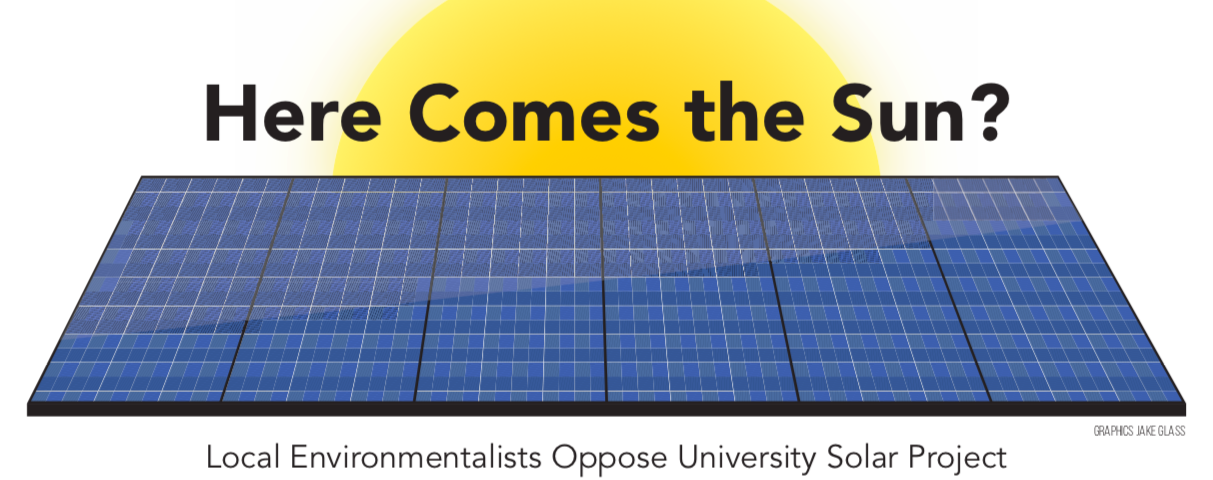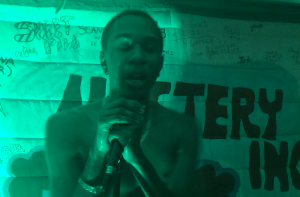When Benjamin Hance decided he wanted to put solar panels on his home, he faced a dilemma. Living on a wooded lot meant trees cast shadows on his roof, and most solar companies he talked to were hesitant to sign on to the job. But one company—he did not say which—told him they could do it by taking down “just a couple trees” to allow more sunlight to reach his roof.
Hance, a member of the Southern Maryland Sierra Club, did not take their offer but rather had solar panels installed by a different company. “That was a non-starter,” Hance said. “What would be the point if I wanted to lower my carbon impact of taking out two or three large, old trees that have already sequestered carbon and continue to do so?”
Hance and a number of citizens in La Plata, Maryland, are asking the same questions about a proposed solar panel installation that Georgetown is financing: Should natural resources be sacrificed for renewable energy?
Not far from Hance’s house in Charles County are 537 mostly wooded acres, a part of the larger Nanjemoy Forest and a Maryland Audubon Society Important Bird Area because of the variety of bird species found there. The Maryland Department of Natural Resources labeled the land a “Targeted Ecological Area” for its rare species and wildlife habitat, making it one of the most ecologically valuable areas in Maryland.
Georgetown has entered into a power purchase agreement with MD Solar 1, a subsidiary of Origis Energy USA, to construct a 32.5 megawatt, 249 acre solar installation on the property.
Xavier Rivera, director of utilities and energy management at Georgetown, wrote in a statement to the Voice that under the provisions of the agreement, Origis will build the facility, and Georgetown will buy power at a guaranteed price for the 20-year term of the agreement.
“The University’s commitment to purchase the power is important to the project’s ability to attain financing, and thus Georgetown plays a catalyzing role in bringing new renewable power to our regional electric grid,” Rivera wrote. “The University will own the ‘renewable energy certificates,’ which certify that the power is from a renewable source, bundled together with the power purchase.”
The installation’s completion, however, will require a large part of the property to be cleared of trees. This has led local conservation groups like the Southern Maryland Sierra Club to oppose the project. Members believe that cutting down trees to build solar panels is counterproductive.
Hance said that this is the same problem he faced when getting solar panels for his roof, but on a much larger scale and with the wrong outcome. “If Georgetown wanted to put these solar panels on the roof of a Walmart, or over all of their parking lots on campus, or even old, monoculture farm fields that are essentially spent, something like that is a much lower impact,” Hance said. “It is the clear-cutting of hundreds of acres that is the problem.”
The installation, announced in September 2017, would provide almost half of the electricity used by the university. Greg Simmons, interim vice president for planning and facilities management, wrote in a statement to the Voice that the university reviewed 60 proposals before settling on Origis “based on overall holistic benefits from the project.” Alongside the project, the Origis Energy Foundation will support scholarships for undergraduate students with demonstrated financial need.
The installation would be a significant step by the university toward meeting its pledge to reduce greenhouse gas emissions by 50 percent from 2006 levels by 2020. Simmons wrote that the installation would provide enough electricity to power 3,000 single-family homes, far more than would be possible with on-campus installations. “Due to space constraints on our physical campus, even if every inch of the University was covered in solar panels it would provide less than half of the electricity needed to power campus,” Simmons wrote. Along with the announcement of the off-site project, the university said it would also complete a solar project on the roofs of six buildings by the end of the 2017-2018 academic year. The projects were not completed.
Bonnie Bick, conservation chair of the Southern Maryland Sierra Club, believes the need to destroy forest to make room for solar panels means the installation is not in the right location. “What we feel is that solar should be located in areas where it will enhance the environment, such as solar canopies, median strip solar, rooftop solar,” Bick said.
A study of the trees on the property conducted by consulting firm ECS Mid-Atlantic for MD Solar found that there are 506.2 acres of forest on the property. Simmons wrote that 288 of these acres will be protected by Maryland conservation laws, protecting more than half of the trees on the property. “The project will be carefully located on the site such that preserved areas will include most of the largest trees on site, as well as other important ecology such as floodplains, riparian areas and stream buffer zones,” Simmons wrote.
Still, 218 acres of forest will have to be removed to make room for the solar panels. Linda Redding, a local citizen who has been involved in resisting the removal of the forest, called this “greenwashing.” “Green projects do not destroy green resources,” Redding said. She pointed to the negative effects that removing the trees will have on surrounding forests and streams, as well as the area’s microclimate.
Simmons’ statement included estimates showing that the carbon savings of the solar panels would far outweigh the loss of carbon sequestration from the removed trees. “The project will generate approximately 75,000 megawatt-hours of power each year and is expected to reduce carbon emissions equivalent to 28 million pounds of coal or planting over 600,000 trees—the amount of carbon sequestered by approximately 30,000 acres of forest,” Simmons wrote. These numbers were calculated with the Environmental Protection Agency’s greenhouse gas calculator tool using the specific factors of Georgetown’s grid.
The study of the parcel conducted by the Maryland Department of Natural Resources estimated that the area sequesters .58 metric tons of carbon per acre per year. The 218 acres that would be cleared could absorb emissions equivalent to those created by burning 507,236 pounds of coal.
The trees are not the citizens’ only concern, though. Bick said that there are two streams which run through the property that could be affected by the clear-cutting. “These streams are Tier II streams,” Bick said, referring to streams classified by the state as exceeding minimum water quality standards. “These are the highest grade we have in Maryland.” Her concerns stem from the possibility for increased runoff and erosion after deforestation, which would not only impact the streams on the property, but the areas downstream as well.
The environmental review of the property prepared by the consulting firm H&B Solutions for MD Solar states that “no impacts to streams or aquifers are anticipated as a result of the project.” Jason Thomas, director of development for Origis, wrote in a statement to the Voice that the project has been designed with the streams in mind and in accordance with state regulations.
“These regulations, plus strict permit conditions, require the implementation of engineered solutions to maintain or decrease runoff quantity and also protect the quality of nearby streams,” Thomas wrote. “Examples of these protective measures include large vegetative buffers, stormwater management controls, infiltration basins, the preparation of a stormwater pollution prevention plan and environmental monitoring.”
The loss of the trees, potentially decreased water quality, and reduction in carbon sequestration will cost the people of Charles County. The Department of Natural Resources combined these factors and others to estimate that the property has an average value of $2,440 per acre annually. If 218 acres are removed, for example, Charles County will effectively lose $531,920 a year, forever. On the other hand, the local economic benefits would include increased tax receipts from the property and, per Simmons, the creation of 200 jobs during the installations construction.
Bick said residents became aware of the project when MD Solar applied for a special exception with the county. In Charles County, regardless of the property’s current zoning, the construction of a large solar installation requires a special exception from the Board of County Commissioners. The exception was granted unanimously.
Redding said this exception was not in line with the county’s comprehensive plan, which lays out how the county will handle land use and development for the next decade. Specifically, Redding said that the exception did not fall under the plan’s goals for natural resource protection to “conserve large tracts of contiguous forestland and forest interior dwelling bird habitat determined to be of significance due to their value for wildlife habitat, water quality and air quality.”
To appeal the Board of Commissioners’ decision, Redding spent $700 of her own money to file a motion for reconsideration but represented herself. “It was me going up against a lawyer, and she just talked circles around me, and the motion was denied,” Redding said. She suggested that if they could find the funds and hire a lawyer, they could try to take the case to circuit court.
The citizens are running out of options. One is to apply pressure on the university either to withdraw from its contract with Origis or reconsider the location of the proposed installation.
“We want them to understand this is the wrong location and that they don’t want to give solar a bad name,” Bick said.
Hance felt the same way and hoped that there is a way for solar projects to become both more common and more sustainable.
“The idea of using your funds to help develop a solar plant and to increase the amount of solar energy is in itself a fantastic idea and something I would encourage for institutions and people at the individual level. I have solar panels on my roof for that very same reason,” Hance said. “But it has to be well-thought-out, and you have to consider where those panels are going and your environmental impact when putting them in.”
Redding thought that this argument could be very effective in persuading the university, or its students, to take action and alter the course of the project. “What would people say if they were going to cut down 240 acres of Rock Creek Park or the beautiful trees on Georgetown’s campus? That wouldn’t be acceptable,” she said.
Samantha Panchèvre (SFS ’19), GUSA’s sustainability chair and a member of GU Fossil Free, believes that sustainability is a worthwhile goal for the university. But she said that this particular project could have been done better if students had been involved in the decision-making process. “I’m really happy that Georgetown is taking concrete steps to meet their renewable energy goals,” Panchèvre said. “But, I wish they had involved more students in the process, and I hope environmental destruction can be mitigated.”
These competing interests are coming to a head as the project approaches its final hurdle. MD Solar must obtain a letter of authorization from the Maryland Department of the Environment because of the property’s Tier II streams and the potential impact of the construction on the waterways.
The citizens are hoping that they can get a public hearing before the Department of the Environment in one last attempt to block the project. “They haven’t started clear-cutting yet; there are still steps that need to be cleared,” Hance said.
But he also acknowledged that letters of authorization are often granted based upon the decisions of lower appeals boards, meaning the project will likely move forward.
If the project is blocked, locals think there is a chance to save the property for the future. Several people interviewed for this story indicated that there is a conservation group interested in purchasing the property but did not name the group to avoid interfering with any ongoing discussions.
Bick believes that kind of conservation would be the best use for the property. It would protect its natural value and also let it serve a different purpose for institutions like Georgetown as an outdoor classroom. “We’ve always thought of this area below Washington, this Nanjemoy-Mattawoman corridor, as extremely biodiverse,” Bick said. ”It would be much more beneficial for students to come on a tour of the value of this big forest and learn to protect it as opposed to just sitting back and letting it get destroyed out of inattention.”
Redding and the other citizens do not want to discourage Georgetown or any other institution that wants to switch to solar energy, but they believe that there are better ways to do it. “I never thought I’d be fighting a solar project,” she said. “But it was just beyond my imagination that someone would cut down all these trees.”
For Hance, the hour-long drive from the Hilltop to La Plata means the issues with the project can go unnoticed by the Georgetown community. “When it’s out of sight and out of mind here in the boonies, as it were, it can be brushed off a little bit more,” Hance said. “You don’t see the trees coming down, you don’t see the log trucks going in and out.”






[…] a wooded lot meant trees cast shadows on his roof, … Source: Renewable Resources Here Comes the Sun? Local environmentalists oppose university solar project – The Georgetown V… Here Comes the Sun? Local environmentalists oppose university solar project – The […]
Georgetown University, while seeming to promote environmental issues, has contracted with Solar 1 to clear-cut 240 acres of an ecologically sensitive area in rural Charles County MD. The reason: To erect solar panels to bring some power to the Georgetown campus. Sadly, the university doesn’t seem to care about the environment an hour outside of the city. This “out of sight, out of mind” mentality is thoughtless at best and arrogance at its worst,
The 240 acre site is part of the greater Nanjemoy forest, the largest one in Southern Maryland. It has been designated as one of the most ecologically valuable areas in Maryland – the “best of the best” by the State DNR. It contains several Tier 2 streams, the highest water quality rating possible. It is noted for its remarkable biodiversity and valuable wildlife habitat by the Audubon Society and the Sierra Club. It is treasured by those of us who live there and fight to preserve our beautiful, wild countryside.
I support sustainability. I support solar power. There are simply better places to put solar panels: campus rooftops, industrial sites, existing farm fields, median strips. I’m sure the great minds of Georgetown and Solar 1 can come up with a better solution than this dreadful proposal.
they cut 6300 acres here in Spotsylvania va. didn’t see you groups protesting that.
Please find another location for these solar panels. While increasing solar power is a worthy project, clear-cutting 240 acres of trees that are part of a larger forest just does not make sense.
Well written and researched article. Btw, they if this requires a CPCN (certificate of public convenience and necessity) by the MD Public Service Commission , it could be another way to intervene.
how much money does one have to pay, to get a solar farm enrolled at your school. I know the price parents pay for their kids. to be on crew of tennis team.. what team would a solar farm be on..
Hello fellow Noah! Good on you for writing this article. I’m not sure if there have been updates since then, but I would also look into the Piscataway Conoy Tribal Council’s opposition to this solar farm on the grounds of it being on ancestral, occupied Indigenous land. Caroline Hamilton recently wrote an article on native opposition to the solar farm, which I think is an important aspect to the conversation.